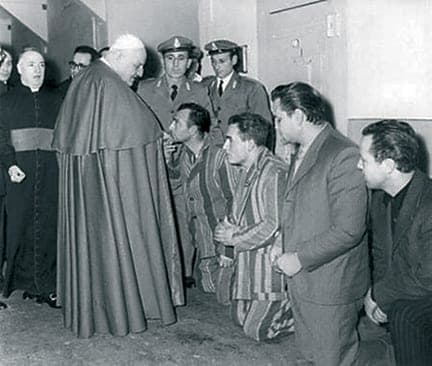ROME – For many Catholics, Pope Francis long has called to mind St. Pope John XXIII, known to Italians as “Good Pope John,” who convened the Second Vatican Council. Like Pope John, Francis is known as a progressive reformer determined to shake up an institution he regards as overly stuffy and rigid, and, also like Pope John, he comes off as a champion of the little guy.
Inevitably, therefore, as Francis visits Rome’s Regina Coeli prison today to celebrate the Mass of the Lord’s Supper on Holy Thursday, including washing the feet of 12 inmates, it will evoke memories of the most celebrated moment when a pope came calling on Regina Coeli – Dec. 26, 1958, when John XXIII became the first pontiff ever to do so.
As recounted by Pope John’s private secretary, Monsignor Louis Capovilla – who was later made a cardinal, and who died in 2016 – Pope John said a few days before that first Christmas as pope, “Listen, Father Loris, my mother taught me that for the holidays we must not only go to Mass, but we must also do works of mercy.”
When Capovilla asked what he had in mind, Pope John replied that he wanted to go to the Bambino Gesù, a papally-sponsored pediatric hospital, on Christmas Day, and the next day he wanted to visit Regina Coeli, Rome’s best-known men’s prison. It was originally a Carmelite convent, and was used during the fascist era to house political prisoners. Today, it can house up to 900 inmates.
The story of what happened when Pope John visited the prison is well known, and frequently retold in Italian literature and Christmastime broadcasts. One has to remember that this was before it was customary for popes to leave the Vatican and meet people in such settings, so there was a fair bit of anxiety in the air – both on the part of the pope’s Vatican aides, who worried about losing control of the situation, and among the inmates themselves, who appeared clearly nervous to be in the pontiff’s presence.
Striving to put people at ease, John XXIII abandoned his prepared text in order to speak, as he put it, “from the heart.” He began by telling the inmates that he had a cousin who once served time for poaching at Regina Coeli, and that it had been a difficult and emotional time – a detail of his biography, as it happens, unfamiliar to his Vatican staff and communications personnel, who, like Francis’s team, often find themselves scrambling to keep up with such spontaneous disclosures from the boss.
(The difference between then and now is that official Vatican reports of that 1958 visit omitted the bit about the pope’s cousin. Today, in the social media era, such attempts at scrubbing the historical record would be entirely futile.)
“You could not leave to see me,” Pope John told the prisoners, “so I have come to see you.”
Speaking to the prisoners, Pope John told them, “Now you need to rebuild your lives and you need to do one thing: eliminate the word ‘despair,’ and prepare yourselves to spend your lives doing good, because this is also the Father’s house and you are also sons of God.”
A 1958 newsreel account of the visit by Universal-International, voiced by the legendary Ed Herlihy, summed it up this way: “With a visit to Rome’s Queen of Heaven prison, Pope John continues to show disregard for tradition and precedent to follow his self-chosen role as a pastoral pope, still in spirit a parish priest.”
When Pope John visited the prison’s ward for those serving life sentences, the inmates dropped to their knees – a scene so powerful, and so imprinted on the imagination of the world at the time, that it’s depicted on John XXIII’s Vatican monument.
Also like several scenes that have played out during Francis’s papacy, at one point an inmate broke through the security barrier, running and throwing himself on his knees at the pope’s feet, asking, “Holy Father, I am a delinquent, is there also hope for me?”
John XXIII replied by affirming that “there is hope for all, there is also hope for you,” and telling him “do not worry.”
When Francis arrives at the Regina Coeli this afternoon, he’s first scheduled to meet sick inmates in the prison’s infirmary. He’ll then say Mass, leaving behind as a gift the altar upon which he celebrates, which depicts in bronze Jesus and the lost sheep, and which was given as a gift to the pope by Italian sculptor Fiorenzo Bacci in 2016.
During the foot-washing ritual as part of the Last Supper Mass, Francis will wash the feet of twelve prisoners from Italy, the Philippines, Morocco, Moldavia, Colombia, Nigeria, and Sierra Leone, four of whom are non-Catholics – two Muslims, a Buddhist, and an Orthodox Christian.
Before returning to the Vatican, Francis will also meet inmates housed in section VIII, set aside for prisoners convicted of sexual offenses.
It remains to be seen how Francis’s afternoon will play out, but one thing seems certain – when Italian prime time TV news covers the story tonight, he likely won’t be the only pope visiting Regina Coeli we see, because that day with John XXIII sixty years ago still feels like yesterday for a surprising cross-section of people here, for whom it wasn’t just a photo op but a synthesis of the Church at its best.














